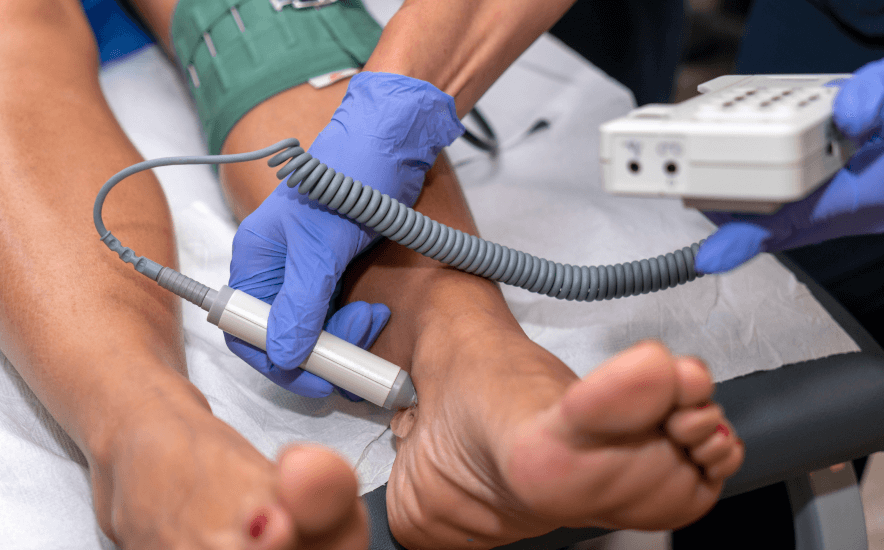
What is Ankle Pain?
Ankle pain refers to discomfort or soreness in the ankle joint, which is where the foot and the leg meet. It can result from injuries, overuse, arthritis, or underlying medical conditions that affect joint function and mobility. Proper diagnosis and treatment are essential to prevent further complications and restore normal movement.



Related Diagnoses

Osteoarthritis

Plantar Fasciitis

Tarsal Tunnel Syndrome

Tendonitis
Expanded Guide
- Osteoarthritis: Ankle osteoarthritis (OA) is a degenerative joint disease that affects the ankle joint, where the bones of the leg (tibia and fibula) meet the foot bone (talus). It occurs when the cartilage that cushions and protects the bones in the ankle gradually wears away over time, leading to bone-on-bone friction. This condition results in pain, stiffness, swelling, and decreased range of motion in the ankle. Unlike hip and knee osteoarthritis, which is often caused by aging and wear and tear, ankle osteoarthritis is commonly linked to a previous injury, such as a fracture or severe sprain. This is known as post-traumatic osteoarthritis. Over time, the joint becomes less functional, and symptoms may worsen, especially with weight-bearing activities like walking or standing.
- Plantar Fasciitis: Plantar fasciitis is a common condition that causes pain in the heel and bottom of the foot. It occurs when the plantar fascia, a thick band of tissue that runs along the sole of the foot connecting the heel bone to the toes, becomes inflamed or irritated. This tissue helps support the arch of the foot and acts as a shock absorber, but when it is overstressed or strained, small tears can develop, leading to inflammation and pain. The hallmark symptom of plantar fasciitis is a stabbing or sharp pain in the heel, particularly when taking the first steps in the morning or after periods of inactivity. Risk factors for developing plantar fasciitis include excessive running or standing, improper footwear, obesity, or having high arches or flat feet.
- Tarsal Tunnel Syndrome: Tarsal tunnel syndrome is a condition that occurs when the tibial nerve, which runs along the inside of the ankle, becomes compressed or pinched as it passes through a narrow space called the tarsal tunnel. The tarsal tunnel is located on the inside of the ankle near the ankle bones and is covered by a thick ligament called the flexor retinaculum, which helps protect the structures in the tunnel, including tendons, blood vessels, and the tibial nerve. When the tibial nerve is compressed, it can cause pain, numbness, tingling, and burning sensations in the ankle, foot, or even the toes. Symptoms may worsen with activity, particularly standing or walking, and can vary in severity. Tarsal tunnel syndrome is often caused by factors like flat feet, injury, inflammation from conditions like arthritis, or the presence of growths like cysts or varicose veins that increase pressure within the tunnel.
- Tendonitis: Ankle tendonitis refers to the inflammation or irritation of the tendons around the ankle joint, often caused by overuse, injury, or repetitive stress. Two common forms of ankle tendonitis are Achilles tendonitis and peroneal tendonitis. Achilles tendonitis affects the Achilles tendon, the largest tendon in the body, which connects the calf muscles to the heel bone. It typically results from overuse in activities like running or jumping and presents as pain or stiffness in the back of the ankle, especially after rest or in the morning. If untreated, it can lead to tendon tears or rupture. Peroneal tendonitis involves inflammation of the peroneal tendons, which run along the outer part of the ankle and foot. These tendons are crucial for stabilizing the ankle during activities such as walking or running on uneven surfaces. The condition is often triggered by repetitive ankle movements or excessive twisting, making it common in athletes or people with high arches. Symptoms include pain, swelling, and tenderness on the outer side of the ankle, particularly during activity.
Frequently Asked Questions
Have more questions? Schedule a consultation with Dr. Patel to gain additional insights and discuss treatment options. We are committed to advancing your health through patient education and a safe, minimally invasive approach.
Ankle pain is diagnosed through a combination of a medical history review, physical examination, and imaging tests. A doctor will assess the patient's symptoms, including the location, duration, and intensity of the pain, as well as any history of injury or overuse. During the physical exam, they will check for swelling, tenderness, range of motion, and signs of instability or deformity. Imaging tests like X-rays, MRIs, or ultrasounds may be used to evaluate the bones, ligaments, tendons, or cartilage for fractures, sprains, tendonitis, or arthritis. In some cases, blood tests may be ordered to rule out infections or inflammatory conditions such as gout or rheumatoid arthritis.
Treatment options for ankle pain vary depending on the cause and severity but typically include rest, ice, compression, and elevation (RICE) to reduce inflammation and swelling. Over-the-counter pain relievers, such as NSAIDs, may help manage pain and inflammation. Physical therapy and stretching exercises are often recommended to improve strength, flexibility, and stability. In cases of tendonitis or ligament injuries, braces or orthotic devices may provide support. For more severe injuries, like fractures or chronic conditions, immobilization with a cast or boot, corticosteroid injections, or even surgical intervention may be necessary. Treating the underlying cause is key to preventing long-term damage.
The duration of ankle pain depends on the cause and severity of the injury or condition. Mild sprains or overuse injuries may heal within a few days to a few weeks with proper rest and care. Moderate to severe sprains, fractures, or tendonitis may take several weeks to months to fully recover. Chronic conditions like arthritis can cause persistent or recurring pain that may require long-term management. Early treatment and rehabilitation can help reduce recovery time and prevent complications.
Untreated or poorly managed ankle pain can lead to complications. These may include chronic pain, persistent swelling, or instability, which can increase the risk of future injuries like repeated sprains. In severe cases, prolonged ankle pain can cause reduced mobility, joint stiffness, or the development of arthritis. For injuries like fractures or severe ligament damage, complications such as improper healing or nerve damage may also occur. Early diagnosis and proper treatment are essential to prevent long-term issues and maintain ankle function.
Gramercy Center
Take the first step towards a healthier life by scheduling your initial consultation with Dr. Patel. At our clinic, we specialize in minimally invasive procedures that offer faster recovery, improved function, and decreased pain. Our client-centered approach ensures that you receive the highest quality care tailored to your unique needs. We look forward to offering you an exceptional experience.
